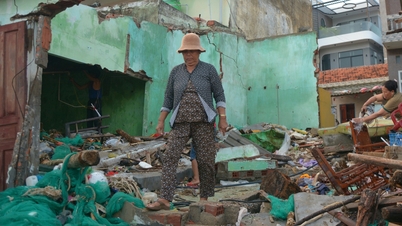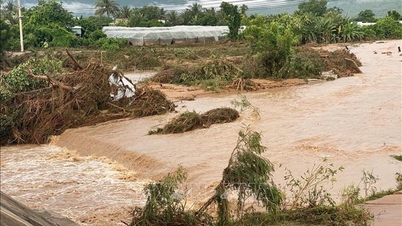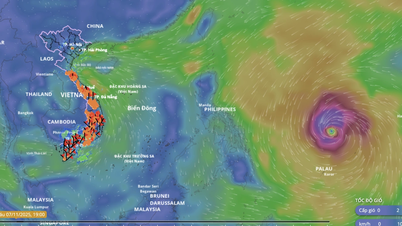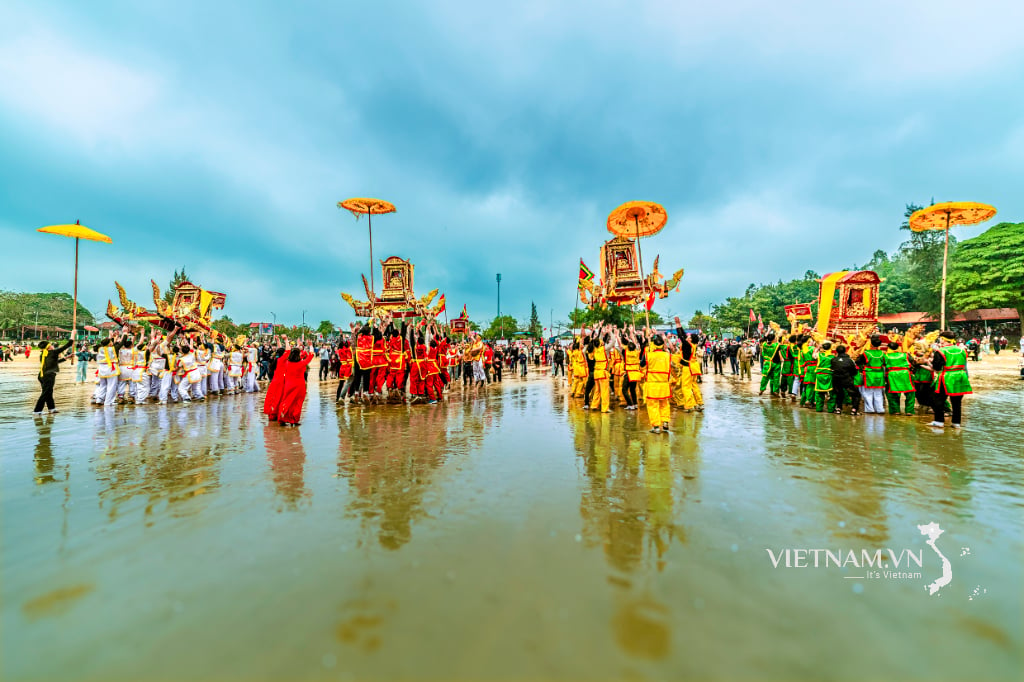
Gia Lai coastal fishing village devastated after storm Kalmaegi.
After one night, there is no home to return to
Early in the morning of November 7, when the storm Kalmaegi receded, the sea of Nhon Hai was strangely quiet. But that silence was not peaceful, but rather heavy and dense, like the choked breath of the earth and sky after a night of screaming.

The embankment of a fishing village in the east of Gia Lai province was devastated by waves.
Looking down from the sandbank, the coastal fishing village of Nhon Hai lay limp under the salty mist. Roofs were torn off by the wind, corrugated iron walls rolled up like dry banana leaves. Coconut trees – the pride of the sea – lay flat on the ground, their roots sticking up pale white.
The once gentle sea is now turbid, waves crashing up to the porch steps, sweeping away nets, buoys, and wooden boats that locals affectionately call “their family’s rice pot”.
On the beach, a boat was tossed upside down by the waves, its hull broken in two. A child’s sandal was scattered on the side of the boat. The smell of salt, mud, and smoke from the collapsed kitchens mixed together to create a mixed smell of loss – fishy, burnt, and haunting.
From early morning, groups of people from the shelters began to return to the village. They walked in small groups, silently walking through the sandy and muddy roads. Everyone wanted to see their home again — where they left behind a rice cooker, a hammock, a few chickens, and familiar things like breathing.
But when they arrived, all that was left was an empty space. The storm had "swallowed" the village.
The villagers walked silently among the ruins, their faces expressionless. They said nothing to each other, only nodded slightly – the nods of people who had passed a sleepless night together.

After returning home one night, the storm had "swallowed" the village, leaving the fishermen's faces dazed.
Before the wind blew, the fishing village was as peaceful as it had been for hundreds of other nights. The rhythmic sound of waves, the distant sound of boat engines offshore, and the barking of dogs echoed from the small sandy path. But around ten o’clock at night, the wind changed direction. It howled, then howled, and tossed in gusts.
Mr. Tran Van Huy - a young fisherman whose house is located close to the coast - recounted, his voice still trembling: " In the storm shelter, I felt the wind whipping as if someone was throwing rocks at the wall. I heard the neighbor's tin roof flying away, all night I lay there worried that my house would be taken away too... now it really has been taken away ." As he spoke, he pointed to the pile of rubble where the house that had been built only two years ago had been. The last piece of wall collapsed when the wind blew for the last time at midnight. Inside, the altar was tilted, the ancestral photo frame was stained with water.
Ms. Pham Thi Giau, 36 years old, her voice became hoarse: " In the twenty years I have lived here, I have never seen the sea so fierce. Waves reached the roof, water rushed into the yard, and even swept away the gas stove ."
They say every storm passes. But the night Kalmaegi tore through this coastal area, it felt less like a natural disaster and more like a ferocious beast that preyed on the weakest spots.
At the coastal hamlet of My An, Phu My Dong commune, in the light of a new day. The fishing village, nestled under the sand, is now a pile of rubble. No roof, no door, only the ground stained with water and human footprints. The wind after the storm still blows through the broken wooden frames, making a sound like the sobbing of the earth.
The waves have crashed deep into residential areas, erasing the boundary between sea and village – between livelihood and shelter.
A man stopped in the middle of the sand, a rusty key in his hand. He looked around — no open doors to be seen.
“ My house is right here… right at the base of this tree… ” he said, his voice faltering, then stopped. The tree he was pointing to had also fallen down, half buried in the sand.
On the other side, a woman was digging in the sand, looking for an old cast iron pot. Every time she turned over a piece of corrugated iron, she bent down, her eyes red. “ I went to avoid the storm, thinking I would come back tomorrow to cook rice like usual. Who would have thought… now I don’t know where to cook rice. ”
Her voice trembled, no longer a complaint, but a sad sigh.
The children were silent. They looked around as if they were lost in a strange place. A little boy held his mother's hand and asked softly, " Mommy, where is our house? "
The mother did not reply, just held her child, looking out to sea. There, the water surface was still rising gently, rippling with white-capped waves, as if hiding something.

The woman from My An fishing village, her eyes red, searched for what was left in the rubble.
On the beach, the men began to look for their boat. The boat, which had been their business and their greatest asset, was now nothing more than a pile of cracked planks, torn nets, and a floating buoy.
“ House lost, boat lost… now everything is gone, ” one person said, his voice as deep as the sound of the retreating sea.
Many people stood still, not knowing whether to cry or what to do in front of that mess.
No one died — because they were evacuated in time — but in their eyes, one could still see the shadow of nameless loss.
People survived the storm, but were left stranded in their own homeland.
Pick up… rebuild
As the sun blazed, the wind became calmer. On the beach, people were still busy picking up every piece of tile and sheet of metal that was still intact. They tried to gather what was left, as they would gather their own lives.
The sound of the waves now sounds strange — not as gentle as before, but sad and distant.

The storm swept away all memories of fishermen in the coastal fishing village of Gia Lai.
“ Yesterday, there was a well and a lamppost here… now they are nowhere to be seen. My house is here, but now only the foundation remains… ” – Mr. Tran Van Lieu, a fisherman from My An village, said with a broken voice.
The sea swept into the village like a wild beast. It not only swept away the roofs, but also the memories.
For fishermen here, the house and the boat are two halves of life. The house is shelter, the boat is livelihood. Losing one is dire – but now they have lost both.
The men who were once steadfast in the face of the storms of the sea, now stood still on the sand, their eyes red.
They did not know where to start again. Out there, the sea still churned with leaden waves, as if its anger had not yet subsided.
An old woman in her seventies sat down on the collapsed floor. Beside her, the bamboo bed had been pushed into the poplar trees, soaking wet. She picked up a torn cotton pillow, wrung it out, and stroked it gently.
“ When I left, I still folded the blanket neatly… now look at this, it's like I never had a home .”
She spoke, then fell silent again, her eyes drifting to the pieces of wood bobbing on the waves.
Deeply saddened, the people of the coastal villages collected each plank and each dented pot. A few men rebuilt the pillars of their houses with driftwood – without saying a word, without complaining – just doing their work.
At noon of the same day, the authorities began to arrive. The soldiers helped the villagers clear away tree branches and set up ladders to rebuild the roofs.
In the afternoon, the sun cleared. The light filtered through the gray clouds, shining on the mottled sea surface, reflecting off the pieces of corrugated iron still stuck to the broken fence.
Huy, after almost a day without sleep, went to the beach to pick up the broken boat frame: “ The sea takes what is ours and then returns it. What we keep is our people. As long as we have the boat and the net, we will work again. ” On the other side of the beach, some children ran out to pick up shells. A mother urged: “ Go back, children, the wind is still strong. ” But they still smiled – a rare smile among the tired faces.
Those smiles, along with the sound of hammers hitting wooden frames, were the first sounds of life after the storm.

Looking at the devastated fishing village after the storm is like a horror movie. For the fishermen here, the house and the boat are two halves of life.
As I left the village, it was drizzling again. A man, who was fixing the corrugated iron wall, called out: “ The sea’s anger will eventually subside. People of the sea, no matter what storms come, must continue to live. Here, we are used to losing – losing and rebuilding. ”
The saying sounds light, but is profound. It is the philosophy of those who live between the fragile boundary between life and nature: the storm passes, the person remains – that is a blessing.
Because here, the sea is not just a livelihood, but a soul. No matter how rough the sea is, they still believe: tomorrow, the waves will calm down, and the sun will rise on this very sand.
Gia Lai devastated after storm No. 13: Winds howling, houses collapsing, power outages across the province
Storm No. 13 (international name Kalmaegi) made landfall on the afternoon of November 6, causing heavy damage to Gia Lai province, especially the eastern region. Many houses, schools, and public works were destroyed.
The whole province had 199 houses collapsed, more than 12,400 houses had their roofs blown off, many residential areas had their corrugated iron roofs blown away by the wind, brick walls collapsed. In the lakeside area, 15 boats sank, 42 were severely damaged, and 334 aquaculture cages and rafts were completely swept away.
On the traffic routes, dozens of large and small landslides isolated many areas. In Po To commune, heavy rain washed away the Dak Po To bridge pier, paralyzing traffic on Provincial Road 674. Authorities had to mobilize machinery, dump trucks, and armored vehicles to open emergency roads and clear fallen trees on more than 20 km of national highway.
The entire province's power grid was paralyzed: 358 power poles and transformer stations were broken, causing widespread loss of communication. By noon on November 7, many communes still had not been able to restore power, communication was interrupted, and information from remote districts was interrupted.
Preliminary statistics from the agricultural sector show that thousands of hectares of rice, crops, and industrial plants have been damaged; hundreds of livestock and poultry have died, causing great losses to farmers. Some mountainous areas are still inaccessible for specific statistics because roads are cut off and phone signals have not been restored.
Particularly heartbreaking, the whole province recorded 2 deaths – Mrs. Nguyen Thi Gia (60 years old, An Nhon ward); Mr. Luu Canh Hung (Bong Son ward). In addition, 8 other people were injured, including children and the elderly.
Initial estimates put the total damage caused by storm No. 13 in Gia Lai at over VND5,000 billion – a figure reflecting the terrible devastation of the natural disaster, even though all residents had been safely evacuated.
An Yen - Nguyen Gia
Vtcnews.vn
Source: https://vtcnews.vn/bao-kalmaegi-nuot-lang-ven-bien-gia-lai-sau-mot-dem-khong-con-nha-de-ve-ar985886.html




![[Photo] Da Nang: Hundreds of people join hands to clean up a vital tourist route after storm No. 13](https://vphoto.vietnam.vn/thumb/1200x675/vietnam/resource/IMAGE/2025/11/07/1762491638903_image-3-1353-jpg.webp)




































































































Comment (0)